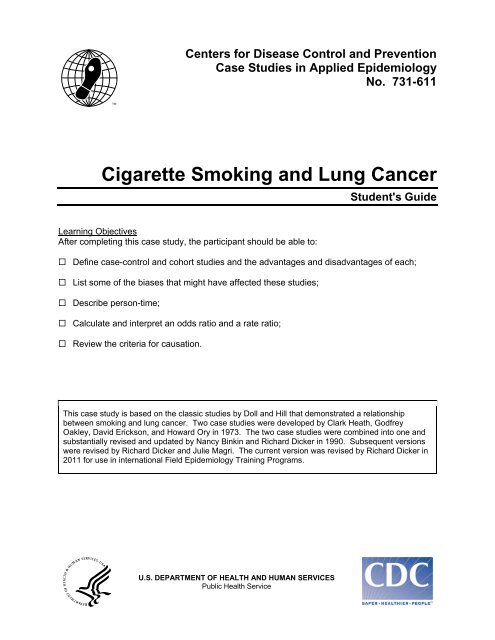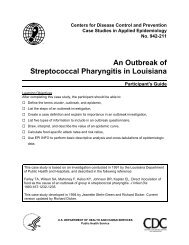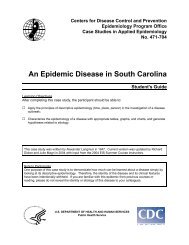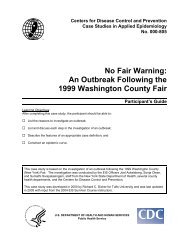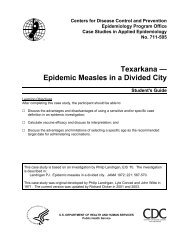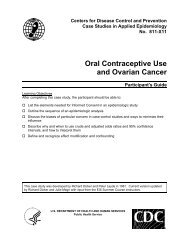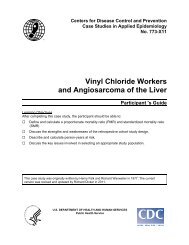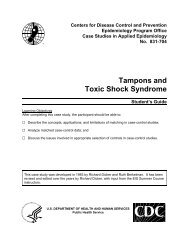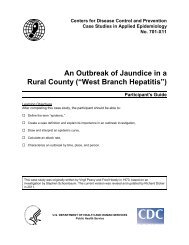Cigarette Smoking and Lung Cancer - Library
Cigarette Smoking and Lung Cancer - Library
Cigarette Smoking and Lung Cancer - Library
Create successful ePaper yourself
Turn your PDF publications into a flip-book with our unique Google optimized e-Paper software.
Centers for Disease Control <strong>and</strong> Prevention<br />
Case Studies in Applied Epidemiology<br />
No. 731-611<br />
<strong>Cigarette</strong> <strong>Smoking</strong> <strong>and</strong> <strong>Lung</strong> <strong>Cancer</strong><br />
Student's Guide<br />
Learning Objectives<br />
After completing this case study, the participant should be able to:<br />
Define case-control <strong>and</strong> cohort studies <strong>and</strong> the advantages <strong>and</strong> disadvantages of each;<br />
List some of the biases that might have affected these studies;<br />
Describe person-time;<br />
Calculate <strong>and</strong> interpret an odds ratio <strong>and</strong> a rate ratio;<br />
Review the criteria for causation.<br />
This case study is based on the classic studies by Doll <strong>and</strong> Hill that demonstrated a relationship<br />
between smoking <strong>and</strong> lung cancer. Two case studies were developed by Clark Heath, Godfrey<br />
Oakley, David Erickson, <strong>and</strong> Howard Ory in 1973. The two case studies were combined into one <strong>and</strong><br />
substantially revised <strong>and</strong> updated by Nancy Binkin <strong>and</strong> Richard Dicker in 1990. Subsequent versions<br />
were revised by Richard Dicker <strong>and</strong> Julie Magri. The current version was revised by Richard Dicker in<br />
2011 for use in international Field Epidemiology Training Programs.<br />
U.S. DEPARTMENT OF HEALTH AND HUMAN SERVICES<br />
Public Health Service
<strong>Smoking</strong> <strong>and</strong> <strong>Lung</strong> <strong>Cancer</strong> (731-611FETP) - Student's Guide Page 2<br />
Part I<br />
A causal relationship between cigarette smoking<br />
<strong>and</strong> lung cancer was first suspected in the<br />
1920s on the basis of clinical observations. To<br />
test this apparent association, numerous<br />
epidemiologic studies were undertaken between<br />
1930 <strong>and</strong> 1960. Two studies were conducted by<br />
Richard Doll <strong>and</strong> Austin Bradford Hill in Great<br />
Britain. The first was a case-control study<br />
begun in 1947 comparing the smoking habits of<br />
lung cancer patients with the smoking habits of<br />
other patients. The second was a cohort study<br />
begun in 1951 recording causes of death among<br />
British physicians in relation to smoking habits. .<br />
This case study deals first with the case-control<br />
study, then with the cohort study.<br />
Data for the case-control study were obtained<br />
from hospitalized patients in London <strong>and</strong> vicinity<br />
over a 4-year period (April 1948 - February<br />
1952). Initially, 20 hospitals, <strong>and</strong> later more,<br />
were asked to notify the investigators of all<br />
patients admitted with a new diagnosis of lung<br />
cancer. These patients were then interviewed<br />
concerning smoking habits, as were controls<br />
selected from patients with other disorders<br />
(primarily non-malignant) who were hospitalized<br />
in the same hospitals at the same time.<br />
Data for the cohort study were obtained from the<br />
population of all physicians listed in the British<br />
Medical Register who resided in Engl<strong>and</strong> <strong>and</strong><br />
Wales as of October 1951. Information about<br />
present <strong>and</strong> past smoking habits was obtained<br />
by questionnaire. Information about lung cancer<br />
came from death certificates <strong>and</strong> other mortality<br />
data recorded during ensuing years.<br />
Question 1: What makes the first study a case-control study?<br />
Question 2: What makes the second study a cohort study?<br />
The remainder of Part I deals with the case-control study.<br />
Question 3a: In a case-control study, what is the purpose of having a control group?
<strong>Smoking</strong> <strong>and</strong> <strong>Lung</strong> <strong>Cancer</strong> (731-611FETP) - Student's Guide Page 3<br />
Question 3b: Why might hospitals have been chosen as the setting for this case-control study?<br />
Question 4: What other sources of cases <strong>and</strong> controls might have been used?<br />
Question 5: What are the advantages of selecting controls from the same hospitals as cases?<br />
Question 6: How representative of all persons with lung cancer are hospitalized patients with lung<br />
cancer?<br />
Question 7: How representative of the general population without lung cancer are hospitalized<br />
patients without lung cancer?
<strong>Smoking</strong> <strong>and</strong> <strong>Lung</strong> <strong>Cancer</strong> (731-611FETP) - Student's Guide Page 4<br />
Question 8: How may these representativeness issues affect interpretation of the study's results?<br />
Over 1,700 patients with lung cancer, all under<br />
age 75, were eligible for the case-control study.<br />
About 15% of these persons were not<br />
interviewed because of death, discharge,<br />
severity of illness, or inability to speak English.<br />
An additional group of patients were interviewed<br />
but later excluded when initial lung cancer<br />
diagnosis proved mistaken. The final study<br />
group included 1,465 cases (1,357 males <strong>and</strong><br />
108 females).<br />
The following table shows the relationship<br />
between cigarette smoking <strong>and</strong> lung cancer<br />
among male cases <strong>and</strong> controls.<br />
Table 1.<br />
<strong>Smoking</strong> status before onset of the present illness, lung cancer cases <strong>and</strong> controls with other<br />
diseases, Great Britain, 1948-1952.<br />
Cases Controls<br />
<strong>Cigarette</strong> smoker 1,350 1,296<br />
Non-smoker 7 61<br />
Total 1,357 1,357<br />
Question 9:<br />
From this table, calculate the proportion of cases <strong>and</strong> controls who smoked.<br />
Proportion smoked, cases:<br />
Proportion smoked, controls:<br />
Question 10: What do you infer from these proportions?
<strong>Smoking</strong> <strong>and</strong> <strong>Lung</strong> <strong>Cancer</strong> (731-611FETP) - Student's Guide Page 5<br />
Question 11:<br />
What is the appropriate measure of association to calculate for a case-control study?<br />
Question 12:<br />
Calculate the measure of association discussed in the previous question.<br />
Question 13:<br />
What do you infer from the odds ratio about the relationship between smoking <strong>and</strong><br />
lung cancer?
<strong>Smoking</strong> <strong>and</strong> <strong>Lung</strong> <strong>Cancer</strong> (731-611FETP) - Student's Guide Page 6<br />
Table 2 shows the frequency distribution of male cases <strong>and</strong> controls by average number of cigarettes<br />
smoked per day.<br />
Table 2.<br />
Most recent amount of cigarettes smoked daily before onset of the present illness, lung<br />
cancer cases <strong>and</strong> controls with other diseases, Great Britain, 1948-1952.<br />
Daily number<br />
of cigarettes # Cases # Controls Odds Ratio<br />
0 7 61 referent<br />
1–14 565 706 _____<br />
15–24 445 408 _____<br />
25+ 340 182 _____<br />
All smokers 1,350 1,296 _____<br />
Total 1,357 1,357<br />
Question 14:<br />
Compute the odds ratio by category of daily cigarette consumption, comparing each<br />
smoking category to nonsmokers.<br />
Question 15:<br />
Interpret these results.
<strong>Smoking</strong> <strong>and</strong> <strong>Lung</strong> <strong>Cancer</strong> (731-611FETP) - Student's Guide Page 7<br />
Although the study demonstrates a clear association between smoking <strong>and</strong> lung cancer, cause-<strong>and</strong>-effect<br />
is not the only explanation.<br />
Question 16:<br />
What are the other possible explanations for the apparent association?
<strong>Smoking</strong> <strong>and</strong> <strong>Lung</strong> <strong>Cancer</strong> (731-611FETP) - Student's Guide Page 8<br />
Part II<br />
This section deals with the cohort study.<br />
Data for the cohort study were obtained from the<br />
population of all physicians listed in the British<br />
Medical Register who resided in Engl<strong>and</strong> <strong>and</strong><br />
Wales as of October 1951. Questionnaires were<br />
mailed in October 1951, to 59,600 physicians.<br />
The questionnaire asked the physicians to<br />
classify themselves into one of three categories:<br />
1) current smoker, 2) ex-smoker, or 3)<br />
nonsmoker.<br />
Smokers <strong>and</strong> ex-smokers were asked the<br />
amount they smoked, their method of smoking,<br />
the age they started to smoke, <strong>and</strong>, if they had<br />
stopped smoking, how long it had been since<br />
they last smoked. Nonsmokers were defined as<br />
persons who had never consistently smoked as<br />
much as one cigarette a day for as long as one<br />
year.<br />
Usable responses to the questionnaire were<br />
received from 40,637 (68%) physicians, of<br />
whom 34,445 were males <strong>and</strong> 6,192 were<br />
females.<br />
Question 17:<br />
How might the response rate of 68% affect the study's results?<br />
The next section of this case study is limited to<br />
the analysis of male physician respondents, 35<br />
years of age or older.<br />
The occurrence of lung cancer in physicians<br />
responding to the questionnaire was<br />
documented over a 10-year period (November<br />
1951 through October 1961) from death<br />
certificates filed with the Registrar General of the<br />
United Kingdom <strong>and</strong> from lists of physician<br />
deaths provided by the British Medical<br />
Association. All certificates indicating that the<br />
decedent was a physician were abstracted. For<br />
each death attributed to lung cancer, medical<br />
records were reviewed to confirm the diagnosis.<br />
Diagnoses of lung cancer were based on the<br />
best evidence available; about 70% were from<br />
biopsy, autopsy, or sputum cytology (combined<br />
with bronchoscopy or X-ray evidence); 29%<br />
were from cytology, bronchoscopy, or X-ray<br />
alone; <strong>and</strong> only 1% were from just case history,<br />
physical examination, or death certificate.<br />
Of 4,597 deaths in the cohort over the 10-year<br />
period, 157 were reported to have been caused<br />
by lung cancer; in 4 of the 157 cases this<br />
diagnosis could not be documented, leaving 153<br />
confirmed deaths from lung cancer.<br />
The following table shows numbers of lung<br />
cancer deaths by daily number of cigarettes<br />
smoked at the time of the 1951 questionnaire<br />
(for male physicians who were nonsmokers <strong>and</strong><br />
current smokers only). Person-years of<br />
observation ("person-years at risk") are given for<br />
each smoking category. The number of<br />
cigarettes smoked was available for 136 of the<br />
persons who died from lung cancer.
<strong>Smoking</strong> <strong>and</strong> <strong>Lung</strong> <strong>Cancer</strong> (731-611FETP) - Student's Guide Page 9<br />
Table 3.<br />
Number <strong>and</strong> rate (per 1,000 person-years) of lung cancer deaths by number of cigarettes<br />
smoked per day, Doll <strong>and</strong> Hill physician cohort study, Great Britain, 1951-1961.<br />
Number of<br />
cigarettes<br />
smoked / day<br />
Number of<br />
deaths from<br />
lung cancer<br />
Person-years<br />
at risk<br />
Mortality rate<br />
per 1000<br />
person-years<br />
Mortality<br />
Rate Ratio<br />
0 3 42,800 0.07 Referent<br />
1–14 22 38,600 ____ ____<br />
15–24 54 38,900 ____ ____<br />
25+ 57 25,100 ____ ____<br />
All smokers 133 102,600 ____ ____<br />
Total 136 145,400 ____<br />
Question 18:<br />
What are person-years at risk?<br />
Question 19:<br />
Compute the lung cancer mortality rate <strong>and</strong> rate ratio for each smoking category.
<strong>Smoking</strong> <strong>and</strong> <strong>Lung</strong> <strong>Cancer</strong> (731-611FETP) - Student's Guide Page 10<br />
The attributable risk percent (AR%) is a measure of public health impact that expresses the excess<br />
lung cancer deaths attributable to smoking as a percentage of all lung cancer mortality among all<br />
smokers. The attributable risk percent is usually calculated in one of two ways:<br />
AR% = (Incidence exposed − Incidence unexposed ) / Incidence exposed<br />
AR% = (RR − 1) / RR<br />
Question 19:<br />
What proportion of lung cancer deaths among all smokers can be attributed to<br />
smoking?<br />
Question 20:<br />
If no one had smoked, how many deaths from lung cancer would have been averted?
<strong>Smoking</strong> <strong>and</strong> <strong>Lung</strong> <strong>Cancer</strong> (731-611FETP) - Student's Guide Page 11<br />
The cohort study also provided mortality rates<br />
for cardiovascular disease among smokers <strong>and</strong><br />
nonsmokers.<br />
The following table presents lung cancer<br />
mortality data <strong>and</strong> comparable cardiovascular<br />
disease mortality data.<br />
Table 4. Mortality rates per 1,000 person-years, rate ratios, <strong>and</strong> excess deaths from lung cancer <strong>and</strong><br />
cardiovascular disease by smoking status, Doll <strong>and</strong> Hill physician cohort study, Great Britain,<br />
1951–1961<br />
Mortality rate per 1,000 person-years<br />
Non-<br />
Excess deaths<br />
per 1,000<br />
Smokers smokers All Rate ratio person-years<br />
Attributable<br />
risk percent<br />
among<br />
smokers<br />
<strong>Lung</strong> cancer 1.30 0.07 0.94 18.5 1.23 95%<br />
Cardiovascular<br />
disease<br />
9.51 7.32 8.87 1.3 2.19 23%<br />
Question 21:<br />
Which cause of death has a stronger association with smoking? Why?<br />
Based on the numbers provided in this table,<br />
<strong>and</strong> using additional formulas, one can calculate<br />
the number of lives saved from each cause, if all<br />
smoking could be eliminated. If no one smoked,<br />
the number of deaths prevented would be 87<br />
deaths from lung cancer per 100,000 persons<br />
per year, <strong>and</strong> 154 deaths from cardiovascular<br />
disease per 100,000 persons per year.<br />
Question 22:<br />
If the smoking attributable risk percent for lung cancer is so much higher than it is for<br />
cardiovascular disease (95% vs. 23%), why would elimination of smoking prevent<br />
more cardiovascular disease deaths than lung cancer deaths?
<strong>Smoking</strong> <strong>and</strong> <strong>Lung</strong> <strong>Cancer</strong> (731-611FETP) - Student's Guide Page 12<br />
The following table shows the relationship between smoking <strong>and</strong> lung cancer mortality in terms of the<br />
effects of stopping smoking.<br />
Table 5. Number <strong>and</strong> rate (per 1,000 person-years) of lung cancer deaths for current smokers <strong>and</strong> exsmokers<br />
by years since quitting, Doll <strong>and</strong> Hill physician cohort study, Great Britain, 1951-1961.<br />
<strong>Cigarette</strong> smoking status<br />
<strong>Lung</strong> cancer<br />
deaths<br />
Rate per 1000<br />
person-years Rate Ratio<br />
Current smokers 133 1.30 18.5<br />
For ex-smokers, years since quitting:<br />
<strong>Smoking</strong> <strong>and</strong> <strong>Lung</strong> <strong>Cancer</strong> (731-611FETP) - Student's Guide Page 13<br />
Part III<br />
As noted at the beginning of this case study,<br />
Doll <strong>and</strong> Hill began their case control study in<br />
1947. They began their cohort study in 1951.<br />
The odds ratios <strong>and</strong> rate ratios from the two<br />
studies by numbers of cigarettes smoked are<br />
given in the table below.<br />
Table 6. Comparison of measures of association from Doll <strong>and</strong> Hill’s 1948-1952 case-control study <strong>and</strong><br />
Doll <strong>and</strong> Hill’s 1951–1961 physician cohort study, by number of cigarettes smoked daily, Great<br />
Britain.<br />
Daily number of<br />
<strong>Cigarette</strong>s smoked<br />
Rate ratio from<br />
cohort study<br />
Odds ratio from<br />
case-control study<br />
0 1.0 (ref) 1.0 (ref)<br />
1–14 8.1 7.0<br />
15–24 19.8 9.5<br />
25+ 32.4 16.3<br />
All smokers 18.5 9.1<br />
Question 24:<br />
Compare the results of the two studies. Comment on the similarities <strong>and</strong> differences<br />
in the computed measures of association.<br />
Question 25: Which type of study (cohort or case-control) would you have done first? Why? Why do<br />
a second study? Why do the other type of study?
<strong>Smoking</strong> <strong>and</strong> <strong>Lung</strong> <strong>Cancer</strong> (731-611FETP) - Student's Guide Page 14<br />
Question 26: What are the advantages <strong>and</strong> disadvantages of case-control vs. cohort studies?<br />
Sample size<br />
Costs<br />
Study time<br />
Rare disease<br />
Rare exposure<br />
Multiple exposures<br />
Multiple outcomes<br />
Progression, spectrum of illness<br />
Disease rates<br />
Recall bias<br />
Loss to follow-up<br />
Selection bias<br />
Case-control<br />
Cohort<br />
Question 27: Which of the following criteria for causality are met by the evidence presented from<br />
these two studies?<br />
Strong association<br />
Consistency among studies<br />
Exposure precedes disease<br />
Dose-response effect<br />
Biologic plausibility<br />
YES<br />
NO
<strong>Smoking</strong> <strong>and</strong> <strong>Lung</strong> <strong>Cancer</strong> (731-611FETP) - Student's Guide Page 15<br />
REFERENCES<br />
1. Doll R, Hill AB. <strong>Smoking</strong> <strong>and</strong> carcinoma of the lung. Brit Med J 1950; 2:739–748.<br />
2. Doll R, Hill AB. A study of the aetiology of carcinoma of the lung. Brit Med J 1952; 2:1271–1286.<br />
3. Doll R, Hill AB. The mortality of doctors in relation to their smoking habits. Brit Med J 1954; 1:1451–<br />
1455.<br />
4. Doll R, Hill AB. <strong>Lung</strong> cancer <strong>and</strong> other causes of death in relation to smoking. Brit Med J 1956;<br />
2:1071–1081.<br />
5. Doll R, Hill AB. Mortality in relation to smoking: 10 years' observation of British doctors. Brit Med J<br />
1964; 1:1399-1410, 1460–1467.<br />
6. U. S. Public Health Service. <strong>Smoking</strong> <strong>and</strong> health. Report of the Advisory Committee to the Surgeon<br />
General of the Public Health Service. US Department of Health, Education, <strong>and</strong> Welfare, PHS,<br />
CDC. PHS Publication No. 1103, 1964.<br />
7. Hill AB. The environment <strong>and</strong> disease: association or causation? Proc R Soc Med 1965;58:295–<br />
300.<br />
8. Levy RA, Marimont RB. Lies, damned lies, <strong>and</strong> 400,000 smoking-related deaths. Regulation 1998;<br />
21–29.<br />
9. Malarcher AM, Schulman J, Epstein LA, et al. Methodological issues in estimating smokingattributable<br />
mortality in the United States. Am J Epidemiol 2000;152(6):573–84.<br />
10. Doll R, Peto R, Boreham J, Sutherl<strong>and</strong> I. Mortality in relation to smoking: 50 years’ observations on<br />
male British doctors. Brit Med J 2004; 328(7455):1519.


